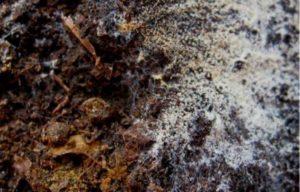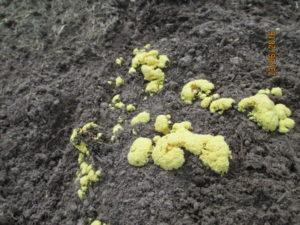Yellow mushrooms in a flower pot and mold on the ground: what is it and where does it come from
Plaque on the ground in flower pots is a fairly common phenomenon. Sometimes it is white and resembles soft fluff, and sometimes it looks more like a hard crust and has a yellow tint. The first type of plaque is usually a dangerous mold, but few people know what the second one is.
Content
Causes of the appearance of yellow plaque on the ground
A yellowish-white, dry coating on the soil in a flower pot usually looks like scale that appears in a teapot. Some flower growers mistakenly assume that the causes of such a raid are:
- insufficient humidity in the room;
- poor watering;
- too acidic soil;
- excessive use of fertilizers.
Actually, these are all myths. The only real reason for the appearance of such a plaque is the composition of the water used for irrigation.
Too hard water, which contains a large amount of salts and alkaline earth metals, leads to the formation of a similar crust on the soil surface.
At first glance, it may seem that the problem will be solved by simply replacing the topsoil. In reality, things are much more serious.
How to get rid of yellow plaque in flower pots
If the plaque has densely covered the topsoil, then it is best to remove it and replace it with a new substrate. In order not to encounter this problem again in the future, you should water the plant with exclusively soft water. To do this, you can use soft purchased bottled water or soften it yourself using one of the proven methods:
- defend water from the tap for at least a day;
- add citric acid to the water in the amount of 1 teaspoon per liter of water;
- boil water;
- purify water from salts using special filters;
- lower cloth bags filled with peat into the water.
Slime Mushrooms
This is a separate group of organisms that are close to fungi, but they are not. The yellow color is the representative of Fuligo putrefactive. This species is inedible, does not represent harm and danger to useful plants. It grows and develops on rotten parts of plants.
In room conditions, this species rarely gets. Only in the case when indoor flowers or seedlings were planted in the soil collected in the garden or on the plot, the slime mold can get into the soil into the room.
Conclusion
Salt deposits that appear due to watering with hard water are quite dangerous for plants. Noticing such symptoms, you should immediately switch to the use of soft water with an acceptable composition. Ignoring the problem and regular watering with low-quality water can eventually lead to slower growth, reduced immunity, and even death of the plant.

